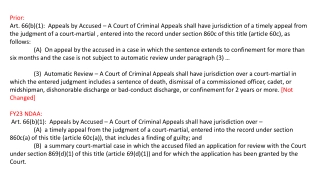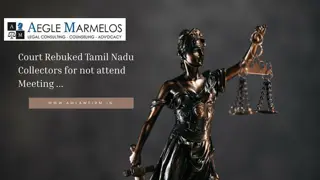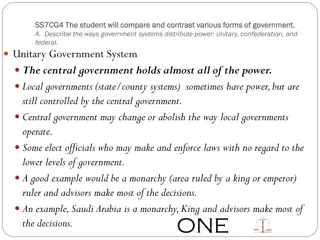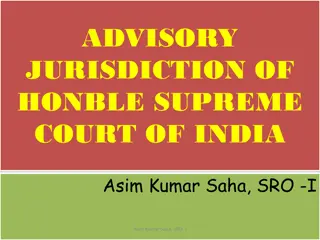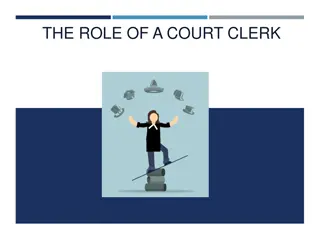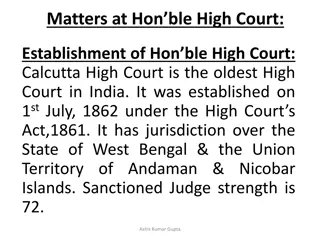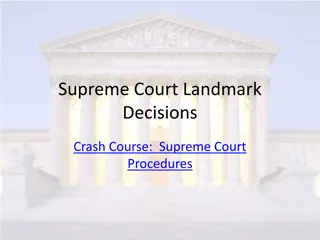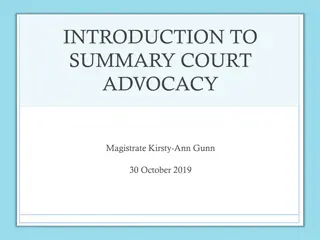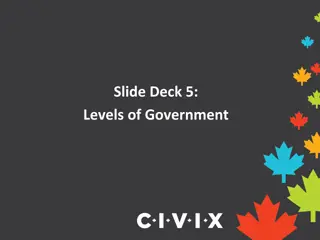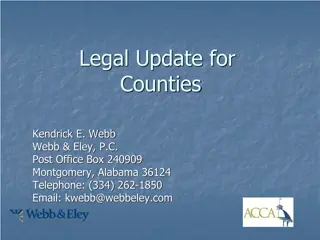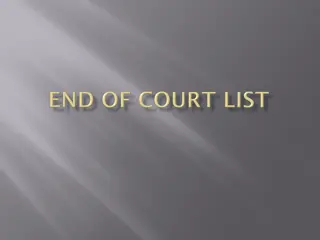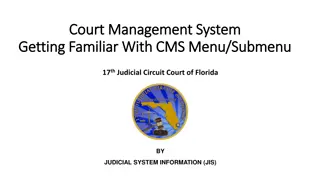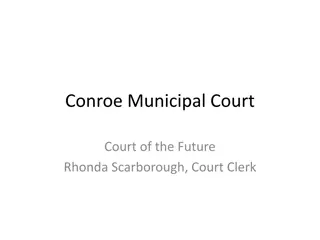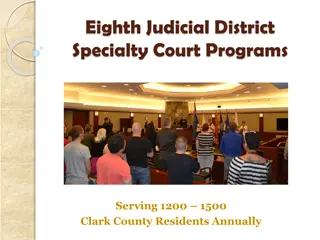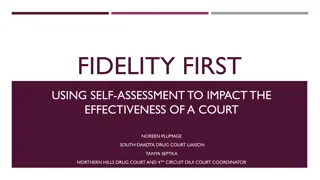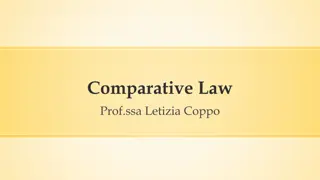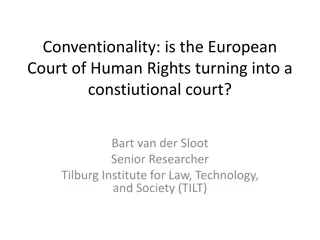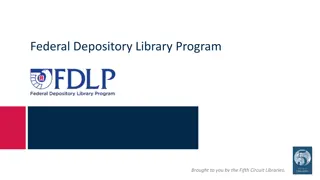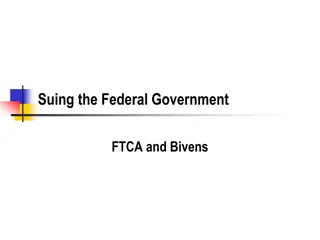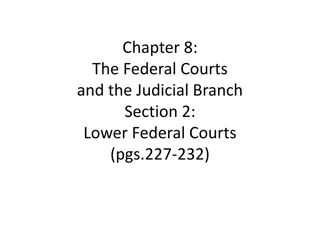Overview of Federal Government Suing and Court Procedures
Explore the history and procedures related to suing the Federal Government, including the establishment of the Court of Claims, the Federal Tort Claims Act, and notable cases like Dalehite v. U.S. Learn about the challenges posed by private bills, jurisdiction of the Court of Claims, and negligence claims against the government. Discover how compensation for tort injuries evolved and understand the legal landscape surrounding government liability.
Download Presentation

Please find below an Image/Link to download the presentation.
The content on the website is provided AS IS for your information and personal use only. It may not be sold, licensed, or shared on other websites without obtaining consent from the author. Download presentation by click this link. If you encounter any issues during the download, it is possible that the publisher has removed the file from their server.
E N D
Presentation Transcript
History US Constitution "No Money shall be drawn from the Treasury, but in Consequence of Appropriations made by Law." U.S. Const. art. I, 9. Traditional Sovereign Immunity Takings Exception nor shall private property be taken for public use, without just compensation. 5thAmd. All compensation had to be by private bills What problems do private bills pose? 2
Formation of the Court of Claims 1855 Administrative tribunal to review claims and make recommendations to Congress Later Congress made the decisions binding Not an Art III court Like bankruptcy courts Appeal to the Federal circuit and the United States Supreme Court 3
Court of Claims Jurisdiction Contracts, tax refunds, takings Not torts Recently some court of claims judges are transforming takings law into tort law. After the failure of the FTCA case involved MRGO, a Court of Claims judge used the same evidence to find a taking. This is still in progress 4
Federal Tort Claims Act Went into effect in 1945 All torts were private bills before then Tied up Congress and encouraged corruption Provides an administrative compensation for certain tort injuries. Looks to the law of the state where the tort occurred for the standards for the tort We will discuss FTCA procedure later. 5
Dalehite v. U.S., 346 U.S. 15 (1953) Texas City Disaster http://www.local1259iaff.org/disaster.html Why is the TVA producing ammonium nitrate fertilizer? What are other uses of ammonium nitrate? Why are we shipping fertilizer to Europe post World War II? 6
The General Claim The negligence charged was that the United States, without definitive investigation of FGAN properties, shipped or permitted shipment to a congested area without warning of the possibility of explosion under certain conditions. LNG terminals? The District Court accepted this theory. 7
Specific Findings by the Trial Court the Government had been careless in drafting and adopting the fertilizer export plan as a whole, specific negligence in various phases of the manufacturing process, and those which emphasized official dereliction of duty in failing to police the shipboard loading. Classic private tort negligence claims. 8
The Statutory Defense (a) Any claim based upon an act or omission of an employee of the Government, exercising due care, in the execution of a statute or regulation, whether or not such statute or regulation be valid, or based upon the exercise or performance or the failure to exercise or perform a discretionary function or duty on the part of a federal agency or an employee of the Government, whether or not the discretion involved be abused. 9
What did the Court say about Discretion? So we know that the draftsmen did not intend it to relieve the Government from liability for such common-law torts as an automobile collision caused by the negligence of an employee of the administering agency. We know it was intended to cover more than the administration of a statute or regulation because it appears disjunctively in the second phrase of the section. The "discretion" protected by the section is not that of the judge -- a power to decide within the limits of positive rules of law subject to judicial review. It is the discretion of the executive or the administrator to act according to one's judgment of the best course, a concept of substantial historical ancestry in American law.
What is the Intent of this Provision? What is a discretionary function? Why do we limit claims based on government decisionmaking? What are the consequences for allowing litigants to challenge government polices? How does this mirror juridical review of rules and adjudications? What is the remedy for bad decisions? What about compensation? 11
The United States Supreme Court Ruling The District Court's holding that the Coast Guard and other agencies were negligent in failing to prevent the fire by regulating storage or loading of the fertilizer in some different fashion is like his specific citations of negligence discussed above. They are classically within the exception. "The power to adopt regulations or bylaws . . . for the preservation of the public health, or to pass ordinances prescribing and regulating the duties of policemen and firemen . . . are generally regarded as discretionary, because, in their nature, they are legislative." The courts have traditionally refused to question the judgments on which they are based.
The United States Supreme Court Ruling What was the dissent concerned about? What are the implications of limiting the liability of the federal government? Why was the majority reticent to make the leap from no liability to full tort liability? 13
Allen v. United States, 816 F.2d 1417 (10th Cir. 1987) In 1950 the AEC chose an area in Nevada as a testing site. The President approved this choice. Thereafter, between 1951 and 1962, eight series of open-air tests were conducted, with the President approving each series of tests. Over one hundred atomic bombs were detonated. Each test explosion was executed according to detailed plans which the AEC officially reviewed and adopted. Separate plans for protecting the public, and for providing the public with appropriate information, were also adopted by the AEC. 14
What are the Plaintiffs Claims? At trial, as a basis for governmental liability, plaintiffs singled out the alleged failure of the government, especially of the Radsafe Officers and the Test Information Officers, to fully monitor offsite fallout exposure and to fully provide needed public information on radioactive fallout. What would have been the effect if the government has told everyone that they were going to be exposed to dangerous, persistent contamination with radioactive material? 15
What Facts did the Trial Court Find? ...the trial court found that the people who designed the downwind safety program deviated from optimum practices based on the best available scientific knowledge. ...the trial court found the following deviations in the plans which would clearly support liability for injury under standard tort analysis as applied by the trial court: the decision to monitor randomly rather than on a "comprehensive, person- specific basis, decisions not to use thyroid or whole body counters decisions regarding the limited extent of urine, fecal, and blood sampling the decision not to test milk samples "in order to avoid arousing public concern, the decisions to forego internal fallout assessment from inhalation of fallout particles decisions regarding the extent of follow-up monitoring in downwind communities et.c. for several more findings. 16
What was the District Courts Legal Holding? Again, on a fully supported record, the trial court found that these departures from accepted safety standards were the proximate cause of suffering and death from cancer in many of the plaintiffs. Under the then-available legal precedents, the trial court reasonably concluded that the FTCA showed Congress's intent that the Government, which benefited from the testing, should bear these particular costs. 17
What was the Governments Defense? Did the government deny that they caused any injuries? Was this an accident? What did the government intend to do? What was the public policy trade-off? National security? Cost-benefit? How does this presage Mathews? Is intentionally putting the public at risk, or even injuring the public, a protected discretionary function? 18
The Supreme Court Ruling on Liability In the instant case, no evidence was presented of any act or omission of the AEC or its employees that clearly contravened a specific statutory or regulatory duty, or that exceeded statutory or regulatory authority. There was no evidence, for example, that the Test Information Officer failed to release information he was required to give out, or that the Radsafe Officer failed to take a specific radiation measurement that had been decided upon. Plaintiffs' entire case rests on the fact that the government could have made better plans. This is probably correct, but it is insufficient for FTCA liability. What would be the result if the agency had violated a statute or regulation? 19
Is there a Duty to Protect the Public? It is irrelevant to the discretion issue whether the AEC or its employees were negligent in failing to adequately" protect the public. When the conduct at issue involves the exercise of discretion by a government agency or employee, 2680(a) preserves governmental immunity "whether or not the discretion involved be abused." For better or worse, plaintiffs here "obtain their 'right to sue from Congress [and] necessarily must take it subject to such restrictions as have been imposed.'"
The Supreme Court Ruling on Policy Our decision here adheres to the principle enunciated by the Supreme Court of broad sovereign immunity. An inevitable consequence of that sovereign immunity is that the United States may escape legal responsibility for injuries that would be compensible if caused by a private party. There remain administrative and legislative remedies; we note the express authorization under 42 U.S.C. 2012(i) for the government to make funds available for damages suffered by the public from nuclear incidents. Nonetheless, judicial reluctance to recognize the sometimes harsh principle of sovereign immunity explains much of the tangle of the prior FTCA cases. 21
FTCA Causes of Action
Causes of Action under the FTCA - Sec 2672 The head of each Federal agency ... may consider, ascertain, adjust, determine, compromise, and settle any claim for money damages against the United States for injury or loss of property or personal injury or death caused by the negligent or wrongful act or omission of any employee of the agency while acting within the scope of his office or employment, under circumstances where the United States, if a private person, would be liable to the claimant in accordance with the law of the place where the act or omission occurred 23
Limitations on Liability - Sec 2674 The United States shall be liable, respecting the provisions of this title relating to tort claims, in the same manner and to the same extent as a private individual under like circumstances, but shall not be liable for interest prior to judgment or for punitive damages. If, however, in any case wherein death was caused, the law of the place where the act or omission complained of occurred provides, or has been construed to provide, for damages only punitive in nature, the United States shall be liable for actual or compensatory damages, measured by the pecuniary injuries resulting from such death to the persons respectively, for whose benefit the action was brought, in lieu thereof. [When the FTCA was passed, dead people were not worth much in many states.] 24
Exceptions to the FTCA - 28 USC Sec 2680 http://biotech.law.lsu.edu/cases/immunity/ftca_exceptions.htm (h) originally did not include this language: Provided, That, with regard to acts or omissions of investigative or law enforcement officers of the United States Government, the provisions of this chapter and section 1346(b) of this title shall apply to any claim arising, on or after the date of the enactment of this proviso, out of assault, battery, false imprisonment, false arrest, abuse of process, or malicious prosecution. For the purpose of this subsection, "investigative or law enforcement officer" means any officer of the United States who is empowered by law to execute searches, to seize evidence, or to make arrests for violations of Federal law. 25
Bivens v. Six Unknown Named Agents, 403 U.S. 388 (1971) Bivens arose from the failure of the FTCA to cover intentional torts by law enforcement officers. Bivens recognized that there is a direct action against federal employees for violations of constitutional rights not covered by the FTCA. Bivens is a personal action, not an official capacity action. No vicarious liability. You must show supervisors know and support the actions that cause the injury. 26
2680(h) - intentional torts by police officers - revised after Bivens Has become a substitute for a Bivens action for covered officers. When would a Bivens action still be possible for intentional torts? A recent case allows a Bivens action against federal medical personnel in a detention center for conscious indifference to a prisoner s medical needs. The 2018 border shooting case probably marks the end new Bivens actions. 27
FTCA Procedure for Making and Contesting a Claim 28
Administrative Procedural Requirements - Sec 2675 An action shall not be instituted upon a claim against the United States for money damages for injury or loss of property or personal injury or death caused by the negligent or wrongful act or omission of any employee of the Government while acting within the scope of his office or employment, unless the claimant shall have first presented the claim to the appropriate Federal agency and his claim shall have been finally denied by the agency in writing and sent by certified or registered mail. 29
Form 95 https://www.va.gov/OGC/docs/SF-95.pdf Request for specific damages. Theory of the negligence involved sufficient to allow the agency to investigate the case and determine what happened. You cannot change or add to the theory after the notice period expires issue preclusion. 30
Filing a Claim is Jurisdictional This is an administrative compensation scheme, so it is subject to exhaustion of remedies You must file a claim with the agency with 2 years of the accident. Sovereign immunity is not waived unless you comply with the procedural requirements. You can only go to court after the agency rules on the claim. If you do not comply with this requirement, your case will be dismissed, and if the 2 years has elapsed, you will be prescribed. 31
What if the Agency Does Not Act on the Claim? "The failure of an agency to make final disposition of a claim within six months after it is filed shall, at the option of the claimant any time thereafter, be deemed a final denial of the claim for purposes of this section. It does not appear that there is a limitation on how long you have to file after the denial or the expiration of 6 months. 32
Suing the Military Exception to FTCA (j) Any claim arising out of the combatant activities of the military or naval forces, or the Coast Guard, during time of war. Civilians can sue subject to this exception Activity duty military Feres v. U.S., 340 U.S. 135 (1950) Cannot sue military provides its own comp system Would undermine military discipline 33
Stopped here 34
Flood Control Act of 1928 What happened in 1927? What are the immunity provisions? Flood Control Act of 1928, 33 U. S. C. 702c -- which states that "[n]o liability of any kind shall attach to or rest upon the United States for any damage from or by floods or flood waters at any place" Why did Congress provide this immunity? Does it say this is limited to flood control projects? 36
The Compensation Clause "No liability of any kind shall attach to or rest upon the United States for any damage from or by floods or flood waters at any place: Provided, however, That if in carrying out the purposes of this Act it shall be found that upon any stretch of the banks of the Mississippi River it is impracticable to construct levees, either because such construction is not economically justified or because such construction would unreasonably restrict the flood channel, and lands in such stretch of the river are subjected to overflow and damage which are not now overflowed or damaged by reason of the construction of levees on the opposite banks of the river it shall be the duty of the Secretary of War and the Chief of Engineers to institute proceedings on behalf of the United States Government to acquire either the absolute ownership of the lands so subjected to overflow and damage or floodage rights over such lands."
How do you get into Court in Flood Act Cases? Is there jurisdiction in the Flood Control Act? Are these Bivens cases? FTCA What do you need to do before you go to court? What do you need to show about the feds decisionmaking?
National Mfg. Co. v. US, 210 F.2d 263 (8th Cir. 1954) GO TO CASE 39
The Claims What were plaintiffs negligence claims? Why not sue for negligence in building the levees too low? Were these claims possible under the FTA? Did the FTCA preempt 702 of the FCA? 40
Does the the FTCA Create New Causes of Action? It is settled in Feres v. United States, supra, quoted in Dalehite v. United States, 346 U.S. 15, 43, 73 S. Ct. 956, 972, 97 L. Ed. 1427, that the Tort Claims Act "did not create new causes of action where none existed before. * * * Its effect is to waive immunity from recognized causes of action and was not to visit the Government with novel and unprecedented liabilities." 41
Is this an Established Cause of Action? "By a long line of cases it has definitely been settled that neither the government nor its instrumentalities would have to respond in damages arising in the development and maintenance of waters for purposes of navigation and flood control, including claims for negligence. It may be noted that this position is not because of governmental immunity from suit but on the grounds of public policy. Does this explain why there was an immunity clause in a 1928 law? 42
What did the Court say about Repeal? The Tort Claims Act contains no expressions which indicate affirmatively that Congress intended to depart from the established prohibition of federal liability for any damages from or by floods or flood waters at any place. "We cannot impute to Congress such a radical departure from established law in the absence of express congressional command."
Consequences of FCA Immunity Surviving the FTCA? Can plaintiff s claim go forward? Why might weather and river level forecasting also be very hard to beat under the discretionary authority defense? Should this apply to Katrina Levee Breach cases?


